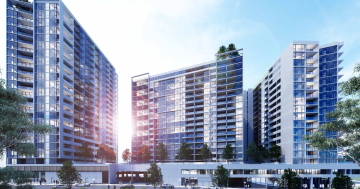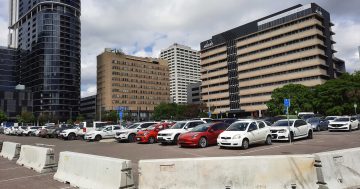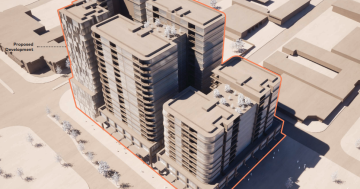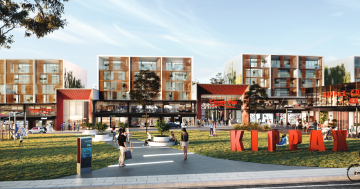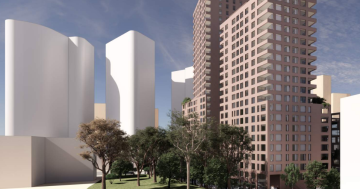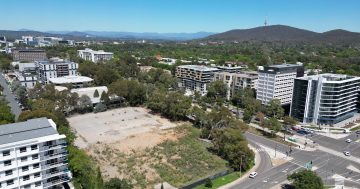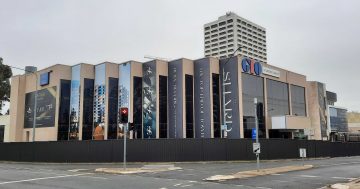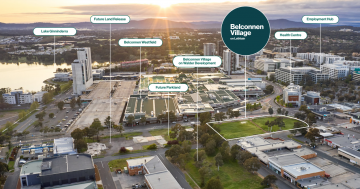
The draft Kippax Town Centre master plan continues the ACT government’s work in modernising our group and town centres in line with contemporary planning principles.
Canberra’s period of highest growth and construction was during the 1960s, a time when town planning prized neatness and separation of use. By building highly segregated residential suburbs, commercial districts, and industrial zones, planners encouraged a high reliance on cars to access jobs and shops.
Aside from issues of sustainability and transport, the biggest problem with this old-fashioned planning approach is that commercial centres become dead zones after hours. This leads vandalism and crime, and areas being perceived as unsafe. Planners now recognise that mixing residential developments with commercial developments is an important “eyes on the street” solution. By creating public spaces where residents and shop patrons are potentially watching at any time, people feel safer and crime levels drop.
Mixed-use developments more closely mimic the natural way that human settlements evolve. They provide important benefits such as access to nearby work, greater housing diversity, a stronger neighbourhood character, and pedestrian/bicycle-friendly environments.
One great initiative from Canberra’s early days was the Y-plan. This embedded the concept of mixed-use at the district level, and ensured a range of employment locations outside of the CBD that have saved us from the worst of the commuter problems faced in cities like Melbourne.
Mixed-use is also key to most recent developments such as the proposed cross-border development in West Belconnen / Parkwood. Over the next 20-30 years, up to 11,000 dwellings will be constructed. Residents will be able to choose between different precincts and a range of building heights including an urban village (1 to 6 storeys), village edge (1 to 4 storeys), and garden suburbs (1-2 storeys). The higher density regions are designed from the ground up to integrate a variety of uses that will ensure greater vibrancy and a more consistent level of public activity.
Urban infill and densification in our town centres such as Manuka/Kingston and Belconnen has also relied upon mixed-use principles. A greater residential population has led to more cafes and restaurants operating outside of business hours, creating a feel of activity and life.
By comparison, group centres such as Kippax and Jamison haven’t evolved significantly and while they may be a hive of activity during the day, they feel quite lonely and exposed after hours.
The influential urban activist Jane Jacobs championed the benefits for “density in generating vitality and the economic and social importance of diversity”, but cautioned that planning needs “careful observation and analysis of the way urban places actually work, rather than focusing on their outward appearance”.
In Canberra, a key challenge is to improve the liveability of town and group centres while respecting that suburban areas with few local facilities like Spence and Flynn will rely upon car travel for the foreseeable future. Even here, mixed-use has big benefits. We are seeing more activity flowing back to local shops as our larger centres get busier, encouraging people in our suburbs to walk and take shorter trips.
We are all a product of our times. Some of these changes challenge how we think cities should work. As the planning and urban design firm David Lock Associates wrote: “It is essential that collective consent for the lifestyle and behavioural changes needed to ensure sustainable growth is attained. Collective consent creates a sense of ownership across a community. This requires open and transparent conversations, using a range of techniques and media, in developing a vision for the future.”
One conversation we need to have more is about the function of the Capital Metro tram as more than just a commuter solution. Tram routes are ideal for mixed-use redevelopment, transforming the places they pass into vibrant, local communities where people live, play and work. The social opportunities unlocked by the tram are substantial and it would be a shame if they were ignored because of short-sighted thinking from certain political groups.
Do you agree that mixed-use developments make Canberra more liveable and sustainable?
Kim Fischer is a regular RiotACT contributor who is set to become a Labor candidate for the seat of Ginninderra at the 2016 ACT election.












